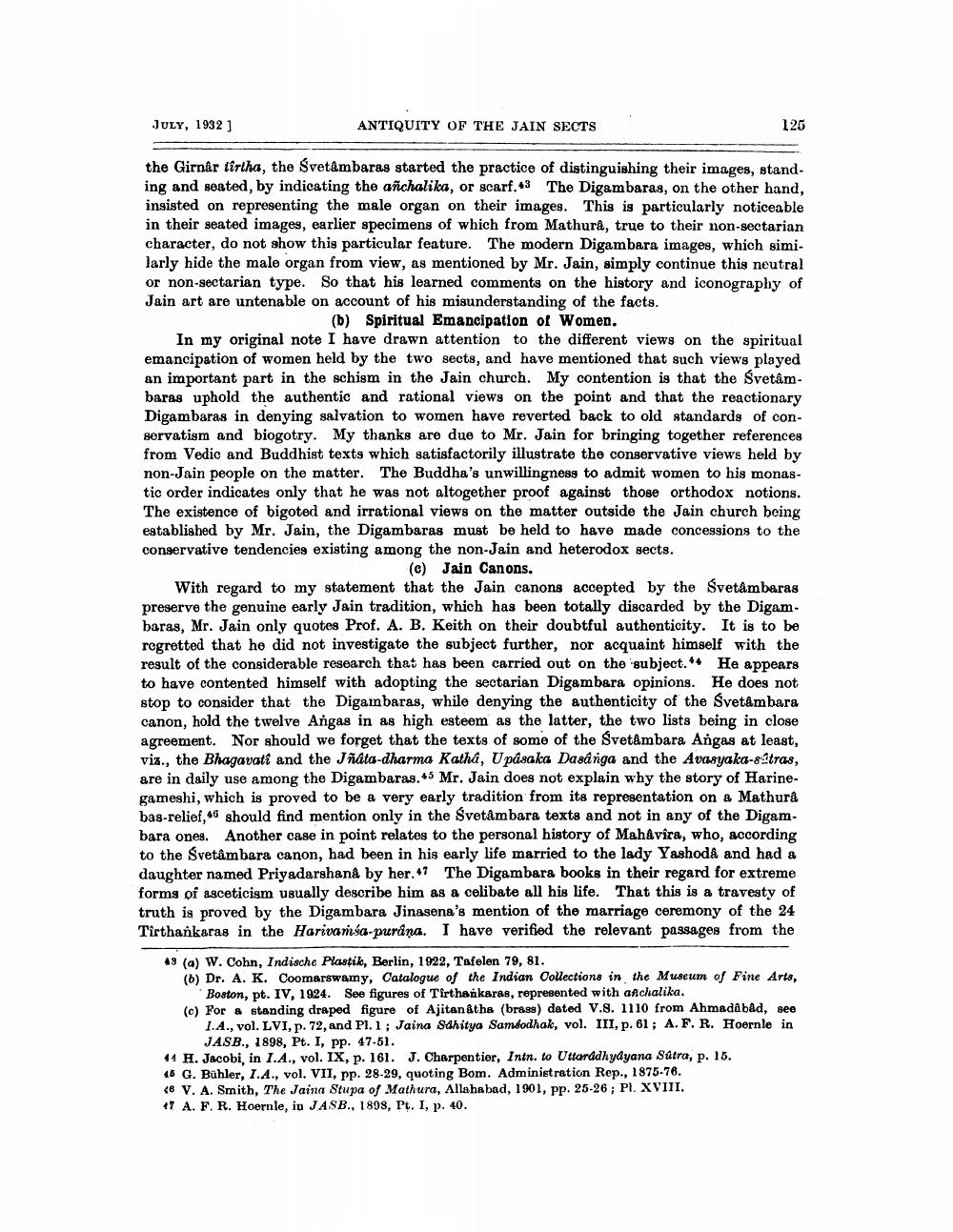________________
JULY, 1932]
ANTIQUITY OF THE JAIN SECTS
125
the Girnar tirtha, the Svetâmbaras started the practice of distinguishing their images, standing and seated, by indicating the añchalika, or scarf.43 The Digambaras, on the other hand, insisted on representing the male organ on their images. This is particularly noticeable in their seated images, earlier specimens of which from Mathurâ, true to their non-sectarian character, do not show this particular feature. The modern Digambara images, which similarly hide the male organ from view, as mentioned by Mr. Jain, simply continue this neutral or non-sectarian type. So that his learned comments on the history and iconography of Jain art are untenable on account of his misunderstanding of the facts.
(b) Spiritual Emancipation of Women.
In my original note I have drawn attention to the different views on the spiritual emancipation of women held by the two sects, and have mentioned that such views played an important part in the schism in the Jain church. My contention is that the Svetâmbaras uphold the authentic and rational views on the point and that the reactionary Digambaras in denying salvation to women have reverted back to old standards of conservatism and biogotry. My thanks are due to Mr. Jain for bringing together references from Vedic and Buddhist texts which satisfactorily illustrate the conservative views held by non-Jain people on the matter. The Buddha's unwillingness to admit women to his monastic order indicates only that he was not altogether proof against those orthodox notions. The existence of bigoted and irrational views on the matter outside the Jain church being established by Mr. Jain, the Digambaras must be held to have made concessions to the conservative tendencies existing among the non-Jain and heterodox sects.
(c) Jain Canons.
With regard to my statement that the Jain canons accepted by the Svetâmbaras preserve the genuine early Jain tradition, which has been totally discarded by the Digambaras, Mr. Jain only quotes Prof. A. B. Keith on their doubtful authenticity. It is to be regretted that he did not investigate the subject further, nor acquaint himself with the result of the considerable research that has been carried out on the subject. He appears to have contented himself with adopting the sectarian Digambara opinions. He does not stop to consider that the Digambaras, while denying the authenticity of the Svetâmbara canon, hold the twelve Angas in as high esteem as the latter, the two lists being in close agreement. Nor should we forget that the texts of some of the Svetâmbara Angas at least, viz., the Bhagavati and the Jñata-dharma Katha, Upasaka Dasanga and the Avasyaka-stras, are in daily use among the Digambaras.45 Mr. Jain does not explain why the story of Harinegameshi, which is proved to be a very early tradition from its representation on a Mathura bas-relief, should find mention only in the Svetâmbara texts and not in any of the Digambara ones. Another case in point relates to the personal history of Mahavira, who, according to the Svetâmbara canon, had been in his early life married to the lady Yashoda and had a daughter named Priyadarshanâ by her. 47 The Digambara books in their regard for extreme forms of asceticism usually describe him as a celibate all his life. That this is a travesty of truth is proved by the Digambara Jinasena's mention of the marriage ceremony of the 24 Tirthankaras in the Harivamsa-purana. I have verified the relevant passages from the
49 (a) W. Cohn, Indische Plastik, Berlin, 1922, Tafelen 79, 81.
(b) Dr. A. K. Coomarswamy, Catalogue of the Indian Collections in the Museum of Fine Arts, Boston, pt. IV, 1924. See figures of Tirthankaras, represented with anchalika.
(c) For a standing draped figure of Ajitanatha (brass) dated V.S. 1110 from Ahmadâbâd, see
I.A., vol. LVI, p. 72, and Pl. 1; Jaina Sahitya Sambodhak, vol. III, p. 61; A. F. R. Hoernle in JASB., 1898, Pt. I, pp. 47-51.
44 H. Jacobi, in I.A., vol. IX, p. 161. J. Charpentier, Intn. to Uttaradhyayana Sútra, p. 15.
45 G. Bühler, I.A., vol. VII, pp. 28-29, quoting Bom. Administration Rep., 1875-76.
<8 V. A. Smith, The Jaina Stupa of Mathura, Allahabad, 1901, pp. 25-26; Pl. XVIII.
47 A. F. R. Hoernle, in JASB., 1898, Pt. I, p. 40.




